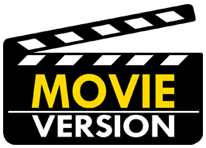Movie Version study guides compare the movie to the book.
Find out:
WHAT’S IN THE MOVIE THAT’S NOT IN THE BOOK?
WHAT’S IN THE BOOK THAT’S NOT IN THE MOVIE?
WHAT’S THE SAME?
Movie Version study guides contain:
- Best movie version
- Scene-by-scene comparison with book chapters
- Errors and omissions in the movie cited for each chapter
- Complete summaries of each book chapter
- Key book chapters recommended
- Quiz and Answer Key
How accurate is the movie?
Movie Version study guides rate movies for accuracy of:
PLOT - CHARACTERS - SETTINGS - SYMBOLS - STRUCTURE - THEMES
A Teacher Time-Saver! Perfect for CCSS, Distance Learning, or Homeschooling.
The Common Core Standards call for comparing the novel text to a different version, especially a film version. Movie Version study guides provide reliable information about the comparison to know if student responses are accurate.
What's the difference between the MOVIE and the BOOK? What's the best MOVIE VERSION to watch?
THE MOVIE
The best film version is recommended based on accuracy and availability.
Each MOVIE VERSION study guide includes a scene-by-scene comparison with corresponding chapters in the book.Errors and omissions in the movie are cited for each chapter. You can immediately find out if the movie follows the book, which parts of the book are similar to the movie and which are different from the film version.
A Comments section points out major differences between the movie and the novel.
HOW ACCURATE IS THE MOVIE?
Recommended movies are rated for accuracy of plot, characters, settings, symbols, structure, and themes.
MOVIE VERSION study guides list major differences between the movie and the book, including:
WHAT’S IN THE MOVIE THAT’S NOT IN THE BOOK?
WHAT’S IN THE BOOK THAT’S NOT IN THE MOVIE?
WHAT’S THE SAME?
THE BOOK
- Complete summaries of each chapter in the book are presented.
- Use chapter summaries to compare and contrast the book versus the movie.
- The MOVIE VERSION format allows you to compare Chapter 1 in the book with Chapter 1 in the movie.
- You can easily see if the movie goes by the book and identify similarities and differences.
- Characters in the book are often left out of the movie, their names are changed, or characters appear in the movie who are not in the book.
KEY CHAPTERS
Some scenes in the movie are completely different from the book.
We recommend reading a few key chapters to find out what really happened.
Movie Trivia:
MOVIE VS BOOK
- Movies let us watch what’s happening.
- Books let us feel what’s happening.
- Movies rush through the story in two hours.
- Reading is a leisurely experience.
- We read a book a little at a time over days or weeks.
FIRST MOVIE OF A BOOK
- The first movie of a book was Sherlock Holmes Baffled, a 30-second black and white silent film that debuted April 26, 1900 in New York City.
- The film was adapted from a short story by Arthur Conan Doyle.
- Viewers in amusement arcades watched the film on individual peep show machines called Mutascopes.
WHY THE DIFFERENCE?
Why is the adaptation of the book so different from the film? The answer is TIME.
The screenwriter has to cut out subplots, characters, settings, and descriptive passages in order to reduce a plot to its bare bones.
Sometimes screenwriters add characters to create conflict, romance, or to recite dialogue that advances the plot.
What we see on the screen is a summary of the book.
HOW MUCH IS LEFT OUT?
How much of a book is omitted from the movie version?
- Wired magazine analyzed 18 recent films to find out. The result: 1,000 book words equal 2 screen minutes.
- A thousand words is roughly 4-6 pages depending on type size, page layout and use of dialogue and description.
- Using the Wired formula, at least 25% of a book is omitted from the movie version.
- The films analyzed by Wired include three series (Lord of the Rings, Harry Potter, Chronicles of Narnia), plus the print and movie versions of Blade Runner, Coraline, Fight Club, and The Shining.
SCREENWRITER VS AUTHOR
- The screenwriter of the film and the author of the book have the same goals in mind. Both use storytelling patterns.
- The filmmaker tells the story with images, using lighting, camera angles, costumes, makeup, and physical action.
- The book author tells the story with words that create images in the reader’s imagination.
AUTHORS WHO WROTE SCREENPLAYS
Famous novelists also wrote the screenplay for the movie version of their book including: Amy Tan (The Joy Luck Club), Vladimir Nabokov (Lolita), and John Irving (The Cider House Rules).
Some famous novelists wrote screenplays of books they didn’t write. Ray Bradbury (Fahrenheit 451) wrote the screenplay for Moby Dick. William Faulkner (The Sound and the Fury) wrote The Big Sleep. Aldous Huxley (Brave New World) wrote the 1940 film version of Pride and Prejudice and the 1943 version of Jane Eyre.
Children’s book author Roald Dahl (Charlie and the Chocolate Factory) wrote the James Bond film You Only Live Twice.

